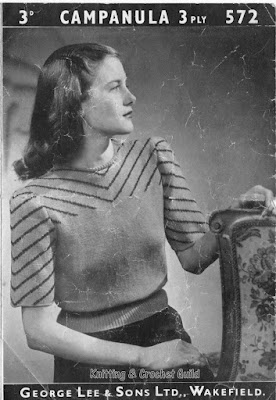The designs are all knitted in 3-ply wool, to a tension of around 32 stitches and 42 rows to 10 cm. in stocking stitch. That's typical of 1940s clothes rationing, when a little knitting wool had to go a long way.
The first design is a neat blouse with bands of lace.
 |
| Lee Target 585 |
"In perfect accord with present-day simplicity, this model is knitted in wide bands of stocking web and lattice lace. The welts and borders are in twisted ribbing and a lace collar adds softness to the neckline."The next design could be knitted with long sleeves, instead of the short sleeves shown, if you had enough wool. The pattern also suggests the colours to use.
 |
| Lee Target 572 |
"Diagonal lines are very much the vogue now and this little model is a happy example. It is knitted mainly in stocking web in a Dusky Pink with Wine-coloured diagonal stripes on yoke and sleeves, a rib welt and narrow rib roll at neck. It fastens on the shoulders. The stripes are simple to knit, a long strand being used for each with only one ball of main colour at a time."
The diagonal lines on the yoke and sleeves are really eye-catching, and quite simple to achieve. All these patterns give quite detailed instructions, and so knitting the diagonal stripes is described very clearly:
We associate the 1940s with broad shoulders emphasised by shoulder pads, and here's a waistcoat designed to be worn with that style.
"Each diagonal stripe is 2 sts. wide and moves over 1 st. every row from the centre to the sides, right and left. A separate strand of W [Wine] wool about a yard long is used for each stripe and the P [Pink] and W [Wine] wools are twisted round one another once at each change of colour to avoid gaps. The long ends of W [Wine] wool are easy to draw out when they become entangled and a fresh length can be joined on as needed."I'm not sure I believe that the lengths of Wine wool could be easily untangled, but maybe it's true.
We associate the 1940s with broad shoulders emphasised by shoulder pads, and here's a waistcoat designed to be worn with that style.
"Designed for added warmth over the new wing-sleeved models, this Cardigan is knitted in stocking web, with double epaulettes slightly flaring round the upper sections of the deep armholes. Single ribbing is used for welts and border. The lower sections of the armholes are neatly faced for strength."
And finally, another blouse, knitted sideways in narrow stripes.
 |
| Lee Target 565 |
"A cleverly designed model reflecting the mode of the moment is knitted with a raised red pin-stripe on a white ground. The entire garment is knitted sideways with a firm welt on smaller needles, and a neckline which can be buttoned high or worn with open revers. It is easy fitting, snug, and will make a delightful Summer as well as cooler weather blouse."
Lee Target pattern leaflets at that time often specified carefully how to make up the garment once you had knitted it. The instructions for the striped blouse say: "It is an excellent plan to tape the shoulder seams and back neck to prevent stretching." - another reminder of clothes rationing. Clothes had to last a long time, so it was worthwhile putting extra effort into the making up, if it would help them to last longer.
I'm not tempted to knit any of these designs (and not just because 3 ply wool is so fine). But it's fascinating to see how they fitted into 1940s fashion, as well as being so economical with wool.
I'm not tempted to knit any of these designs (and not just because 3 ply wool is so fine). But it's fascinating to see how they fitted into 1940s fashion, as well as being so economical with wool.











